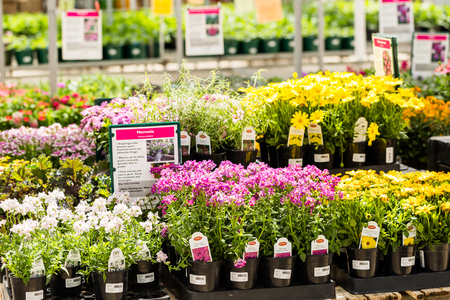Online brand experience: 6 tips
If you let people test two glasses of cola blindfolded, chances are that they would rather drink Pepsi than Coca Cola. Yet Coca Cola is much more popular than Pepsi. How is that possible? Brand experience plays a vital role in the decision-making process of consumers. And it doesn't matter whether they buy Coca Cola or garden furniture: brand experience is essential in most purchase decisions.
Years ago, Pepsi already made it clear that their cola tastes better than the original Coca Cola. This commercial was aired during the 1983 Superbowl:
We're not going to go into why Pepsi doesn’t have a bigger market share than Coca Cola in this blog, but we will look at the role of brands in the garden retail industry. And, of course, we're going to explain to you how you can use online branding to sell more.
In garden centres, branding is already very popular. The Weber shop-in-shop is well-known, but Riverdale does it too. And who is not familiar with displays of plant food? In short, offline, there is a lot of attention on brand experience, but online it is still a bit lacking. Time to change this!
1. The importance of brands
Suppliers who market their products as brands increasingly appear in the gardening sector. Of course, we've known several brands for years because Weber and Westland are no longer brands but have become part of our everyday language. But there are also relatively new brands such as Elho and Addenda that are gaining ground.
In the end, the consumer stands in front of the shelf and has to choose: an unknown brand or a product without a brand, or should he choose something they know from ads & commercials?
Even if you know that something is the same, you often still buy the branded product. In the supermarket, but also in the garden centre: this illustrates the importance of brands.
2. Which brands are known?
So now you know that brands are essential, also in the garden centre or the garden centre webshop. But which brands are known and which are unknown - and therefore unloved? There are hundreds of brands in a garden centre, so we cannot show all of them here.
However, you can use Google Trends to quickly find out which brands are loved and which are less popular.
For example, if you are curious about which barbecues are popular at the moment, you can make a comparison between:
-
Kamado Joe (blue)
-
Weber (red)
-
Ooni (yellow)
You will then see this trend:

What conclusions can you draw from this? First of all, it is noticeable that Kamado Joe and Ooni are the smallest of the three until 2020, but they both have a peak in search volume in the spring of 2020 and 2021.
You can also see that searches in Google for the Weber in 2021 barely exceed 2019, which is strange because 2021 was obviously an outstanding year. Maybe consumers are shifting from Weber towards more premium brands?
Through Google Trends, you can compare all the brands you want yourself.
3. Branding on product pages
You now understand that brands play an essential role in the buying process, and you also know how to find out if a brand is popular. But how can you add brand experience to product pages?
We explained this extensively during our online lunch & learn session because it surprised us how little garden centres apply this. There are several tricks available in the Garden Connect platform to add branding.
The first is simple: adding brand logos to product pages. This seems obvious, yet few webshops do it.

A logo provides instant brand recognition and is easy to add. You don't have to do this for each product: if you link a logo to a brand, the logo will automatically appear on your product pages. Very convenient.
The second trick that few garden centre webshops use is adding a product tab with information about the brand:

This text can provide more information about the brand, its benefits, and what makes the brand unique. You can place the logo again in this text - the power of repetition should never be underestimated! In addition, this text usually contains a link to the Brand page (see below).
You don't need to edit all your products in the Garden Connect platform for this text either. You can easily add text to a brand. This text will then automatically appear on the product pages.
If you do not know precisely how this works, we advise you to watch these two videos:
We have made it as easy as possible within our platform to work with brands. You only have to set it up once per brand, and you don't have to check all your products. If you use a different webshop platform, you will have to find a good working method/solution yourself.
4. Brand pages
We have looked above at brand recognition on product pages. But did you know you can also easily create a digital shop-in-shop? If you have entered the products correctly, you can do this easily.
On the brand page, everything comes together: the logo, the description and all the brand's products in question.

So this is the online version of a shop-in-shop. In fact, you don't have to do anything to create this page. You have to enter the logo for the products anyway, and the text you see here is the same as the text on the product tabs. You can overwrite that text, but you don't have to.
So it's pretty easy to create a brand page, isn’t it?
The products and categories are linked automatically. The only thing you have to do is enter the logos and texts consistently.
If you don't feel like it or don't have the time, our content marketers will be happy to help you: they already have a few hundred logos ready and can create a unique, Google-friendly description of each brand for your webshop.
5. What not to do...
There are many things you can do, but there are also things you shouldn't do. You put a lot of time, effort and money into attracting visitors to your webshop. So it's not advisable to send visitors to the supplier's website.
That sounds a bit unfriendly, but we don't mean it like that.
The supplier puts a lot of energy into attracting attention for his brand, and you help him by applying brand experience to your webshop. But the supplier doesn't really care where his product is sold: as long as it gets sold!

In the above example, we have mentioned Kamado Joe. If you redirect your website's visitors to the Kamado Joe website - for more information, for example - the consumer will see two things there:
- Kamado Joe also has a webshop
- Kamado Joe refers consumers to their points of sale
And they have quite a few of the latter, as you can see above!
From Kamado Joe’s point of view, this makes sense, although the webshop may lead to a channel conflict. But it is their right to set it up this way, just as it is your right not to refer the visitors you attract to your webshop to Kamado Joe or other suppliers!
6. Write blogs about brands
The last tip is to write blogs about brands. Brand loyal consumers see certain products and want to know if they are available nearby.
We've written before that 48% of Google searches are for something to do, buy or visit nearby. And yes, consumers also search for places to buy certain brands nearby.
If you want to capitalise on this, you can create blogs around brands and branded products. When your Christmas show opens, and you want to draw attention to your new Lemax collection, you can create blogs with the following topics:
- Our top-5 Lemax houses of 2022
- These 10 new Lemax houses are not to be missed!
- How we built our Lemax Christmas village: 29 photos
You can see that there is always a number in here: this is not without reason because people simply click more on a title with a number.
Don't forget to mention place names. You can do that tactically, so it is not too obvious:
-
A good example:
The Lemax displays in our garden centre in Northampton attract visitors from near and far. From Coventry, Kettering and even Birmingham!
-
A less good example:
The Lemax displays in our garden centre in Northampton attract visitors from Coventry, Leicester, Kettering, Wellingborough, Luton, Daventry, Corby, Solihull, Stratford-upon-Avon and Bedford.
In other words: don't overdo it because that is annoying for the visitor, and Google also knows it! Blogs are fun to read, and by writing blogs around brands, you can ensure that you are better found with essential brands on Google.
If you don't have the time or the desire to write blogs, our content marketers can help you out. They write one or more unique blogs per week for your garden centre website. Completely customised and fully Google-friendly!
Want to know more about brand experience?
We have given you six tips about brand perception and how you can apply this to your garden centre webshop. If you want to know more, please contact us at +31-20-7008250 or mail info@gardenconnect.com. You can also download our whitepapers or participate in one of our online lunch & learn sessions.



